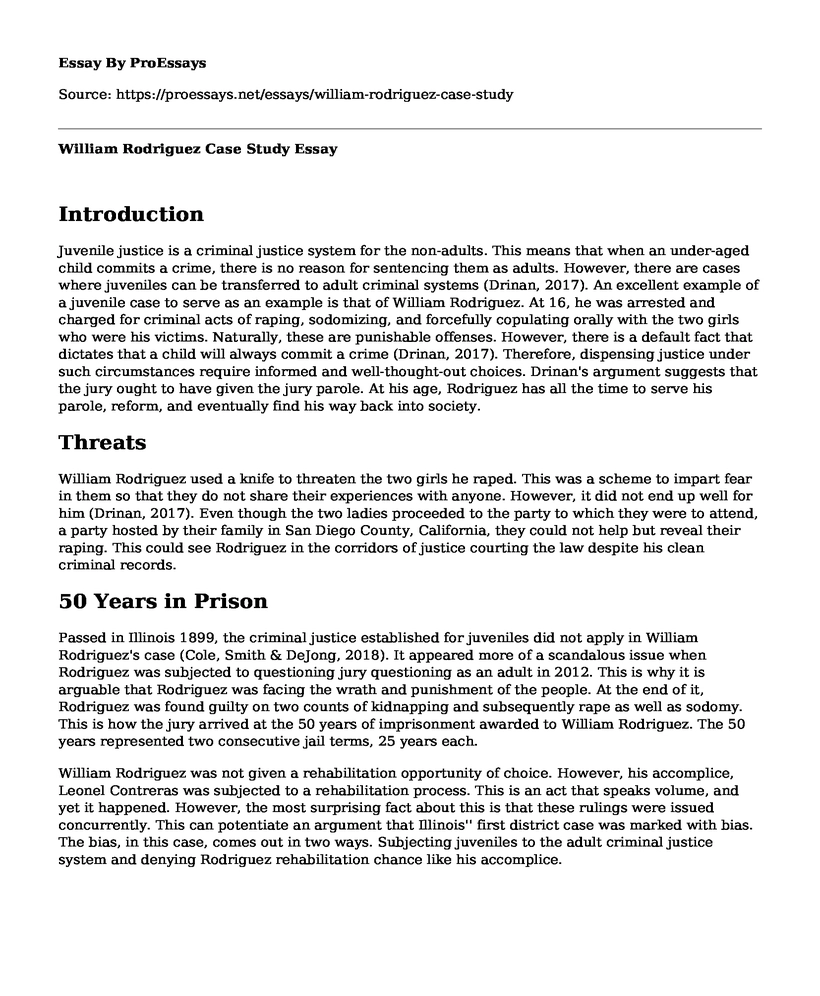Introduction
Juvenile justice is a criminal justice system for the non-adults. This means that when an under-aged child commits a crime, there is no reason for sentencing them as adults. However, there are cases where juveniles can be transferred to adult criminal systems (Drinan, 2017). An excellent example of a juvenile case to serve as an example is that of William Rodriguez. At 16, he was arrested and charged for criminal acts of raping, sodomizing, and forcefully copulating orally with the two girls who were his victims. Naturally, these are punishable offenses. However, there is a default fact that dictates that a child will always commit a crime (Drinan, 2017). Therefore, dispensing justice under such circumstances require informed and well-thought-out choices. Drinan's argument suggests that the jury ought to have given the jury parole. At his age, Rodriguez has all the time to serve his parole, reform, and eventually find his way back into society.
Threats
William Rodriguez used a knife to threaten the two girls he raped. This was a scheme to impart fear in them so that they do not share their experiences with anyone. However, it did not end up well for him (Drinan, 2017). Even though the two ladies proceeded to the party to which they were to attend, a party hosted by their family in San Diego County, California, they could not help but reveal their raping. This could see Rodriguez in the corridors of justice courting the law despite his clean criminal records.
50 Years in Prison
Passed in Illinois 1899, the criminal justice established for juveniles did not apply in William Rodriguez's case (Cole, Smith & DeJong, 2018). It appeared more of a scandalous issue when Rodriguez was subjected to questioning jury questioning as an adult in 2012. This is why it is arguable that Rodriguez was facing the wrath and punishment of the people. At the end of it, Rodriguez was found guilty on two counts of kidnapping and subsequently rape as well as sodomy. This is how the jury arrived at the 50 years of imprisonment awarded to William Rodriguez. The 50 years represented two consecutive jail terms, 25 years each.
William Rodriguez was not given a rehabilitation opportunity of choice. However, his accomplice, Leonel Contreras was subjected to a rehabilitation process. This is an act that speaks volume, and yet it happened. However, the most surprising fact about this is that these rulings were issued concurrently. This can potentiate an argument that Illinois'' first district case was marked with bias. The bias, in this case, comes out in two ways. Subjecting juveniles to the adult criminal justice system and denying Rodriguez rehabilitation chance like his accomplice.
Conclusion
Juvenile criminal justice systems are designed purposefully to handle criminal cases among the juveniles; underage persons. In the United States of America, the bill about this act was passed in 1899, Illinois. Even though the bill was passed in Illinois, that was the place where it was violated, and William Rodriguez was the victim. At 16, he was tried as an adult and sentenced for 50 years on accounts of rape, sodomy, and kidnapping as well as eight counts of oral copulation. This act, by the jury, watered down the essence of the juvenile criminal justice system. Rodriguez may have been involved in a criminal activity that a child of his age hardly commits. However, that was the crime, and it never justified his trial as an adult.
References
Cole, G. F., Smith, C. E., & DeJong, C. (2018). The American system of criminal justice. Cengage Learning. Retrieved from
https://books.google.co.ke/books?id=fA9EDwAAQBAJ&pg=PA790&dq=JUVENILE+SENTENCING+PEOPLE+VS+RODRIGUEZ&hl=en&sa=X&ved=0ahUKEwj1s5Ki873gAhUryIUKHZ3CBxU4ChDoAQgzMAI#v=onepage&q=JUVENILE%20SENTENCING%20PEOPLE%20VS%20RODRIGUEZ&f=false
Drinan, C. H. (2017). War on Kids: How American Juvenile Justice Lost Its Way. Oxford University Press. Retrieved from
https://books.google.co.ke/books?id=h4Y0DwAAQBAJ&printsec=frontcover&dq=what+is+JUVENILE+SENTENCING&hl=en&sa=X&ved=0ahUKEwjzosCA9L3gAhVOExoKHSL5AsQQ6AEIQDAE#v=onepage&q=what%20is%20JUVENILE%20SENTENCING&f=false
Cite this page
William Rodriguez Case Study. (2022, Nov 28). Retrieved from https://proessays.net/essays/william-rodriguez-case-study
If you are the original author of this essay and no longer wish to have it published on the ProEssays website, please click below to request its removal:
- Judicial Systems of Brazil and Canada
- Essay on Body Cameras on Police Officers
- Essay Example on Criminology Schools
- Paper Example on Prison Capacity
- Cybercrime: Unlawful Access & Data Loss Risk From Cookies - Research Paper
- Data Privacy in Health Care: A Comprehensive Overview - Essay Sample
- Bay Area Housing Crisis: Unjust Violation of Human Rights - Essay Sample







